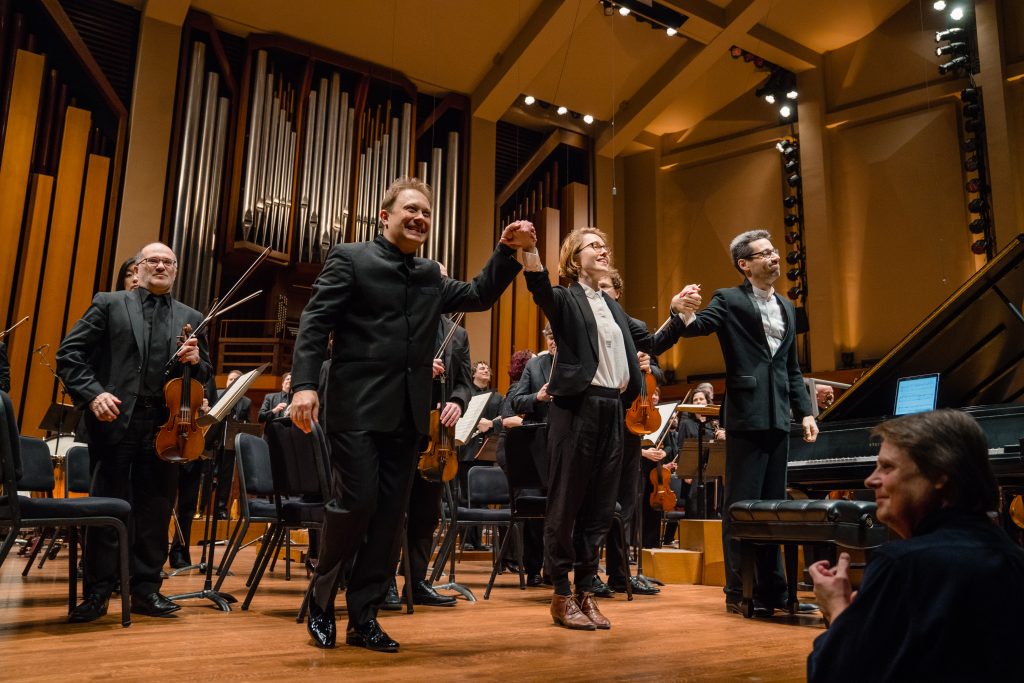By Philippa Kiraly, Special to The Sybaritic Singer
Seattle Symphony photos credit: Brandon Patoc
Pianist Jonathan Biss, considered one of the great Beethoven interpreters of our time, had the novel idea of asking five different composers to write a work which would be, not a follow-on, not a derivation, but perhaps a companion piece to each of the five Beethoven piano concertos. On Thursday, January 31st, 2019, he played Beethoven’s Third Piano concerto with the Seattle Symphony at Benaroya Hall, and immediately following, he performed the premiere of Caroline Shaw’s Watermark, the concerto she has composed in answer to his request, and which is a Seattle Symphony commission.
Thursday night saw the first of three performances of both works, changing the order printed in the program book to have the Beethoven performed first, followed by the Shaw, and after intermission, Shostakovich’s first symphony. Shaw is young, only 35, but the other two works were composed at even younger ages, the Shostakovich at a precocious 19, the Beethoven at 30. It is as exciting now to hear youthful, innovative and original composers as it must have been then.

Shaw’s concerto noticeably mirrors the Beethoven only in its fast-slow-fast order of movements, though there are other areas within the work’s structure which will be readily clear to serious musicians. However, for most concertgoers attending, it will have been the pleasure and uncomplicated enjoyment of the work which appealed to them. And that’s as it should be.
Watermark is the right name for the concerto. From the outset, there is a pervasive feel of water, dripping or flowing throughout, from soft pizzicatos, single notes on the piano, sometimes long-drawn out legato tones on different instruments. Different timbres seemed to denote different qualities of water as it touches a surface. Faster, agitated sections from double basses to the brass, or fast steady beats with long varied notes in the winds all painted a tonal color palette which constantly engaged the ear. A long soliloquy for the piano expanded to include busy strings, winds above, plus percussion beats. Dynamics changed frequently and sometimes suddenly, but the sense of water was always there, sometimes dreamy and hypnotic, sometimes fast and lively, the timpani sometimes syncopated and very much a presence. There were a couple of familiar snatches from the preceding Beethoven concerto, but these then traveled in different directions. The piano was more a part of all this than a separate element, and the orchestra under Ludovic Morlot was always sensitive to the balance between them. The 20-minute concerto ended as it had begun with a single long very quiet note.

The earlier performance of Beethoven’s Third Piano Concerto came across with a contemporary interpretation which seemed too robust, too heavy in the louder sections with a big contrast between those and the softer more lyrical parts. Biss is a master of the lyrical touch, with clean articulation and even runs, so it seemed odd that he should have chosen to play louder sections so forcefully, the orchestra doing likewise. This concerto, after all, was composed in 1800, during what was still the classical age and a time of restraint. The romantic era was only just beginning and while Beethoven was a harbinger of what was to come, he was still playing on a Clementi piano or one of that time and the orchestral instruments were not yet the modern versions we hear now. The whole seemed an uneasy interpretation.
A fine choice for the third work on the program, Shostakovich’s Symphony No. 1 has little of the dark undercurrents we hear in his later work—it’s much sunnier—but has amazing skill and musical maturity for such a young man. There are hints of Prokofiev’s influence which we don’t hear in later works, unless it is that Prokofiev was influenced by him at some point—the two are not quite contemporaries, Prokofiev being the older by 15 years. Seattle Symphony’s many fine soloists shone in the many prominent moments and the whole performance sounded both lighthearted, colorful and rich.
During the latter half of the Shaw work, there was what appeared to be a medical emergency just a row in front of where Shaw was sitting. Several people came and went over about ten minutes with eventually a Fire Department person coming in to help an audience member out.
It’s to be hoped that she was able to come to the second and third performances to hear her work undistracted.

Philippa Kiraly has writing classical music criticism since 1980, for several newspapers in northern Ohio and Seattle, magazines, both local and national, and blogs. She is passionate about the importance of independent criticism for the fine arts, an art in itself which is dying with little interest by many publications and no longer a viable career for most. But writing for tickets is always worthwhile! Pippa is a keen gardener, a keen grandparent, and can get lost in a good book.
